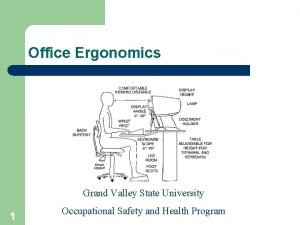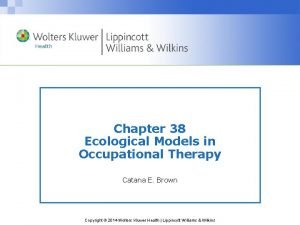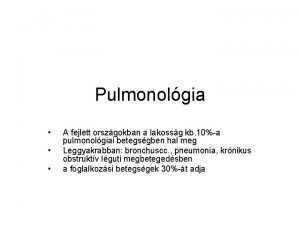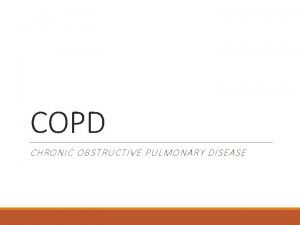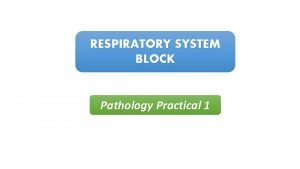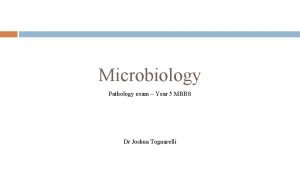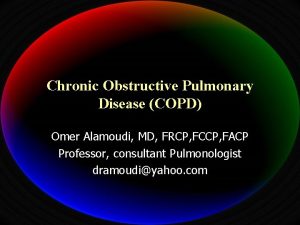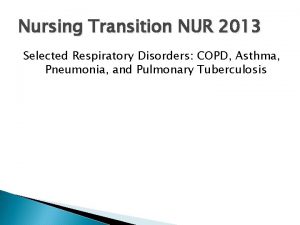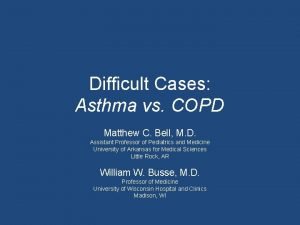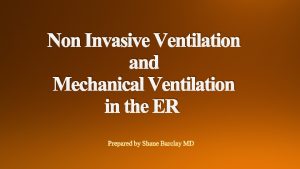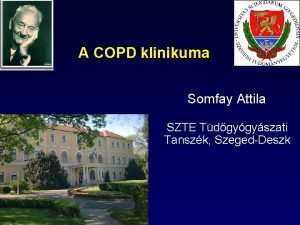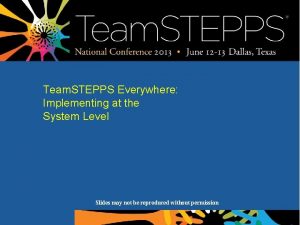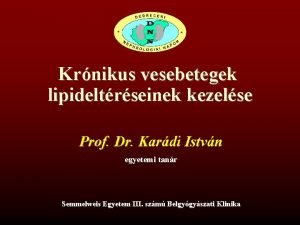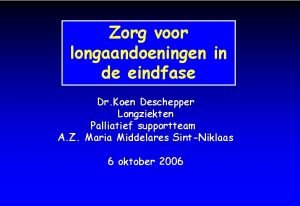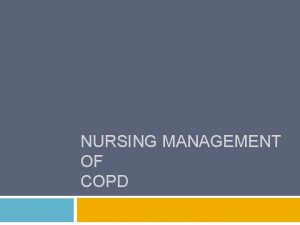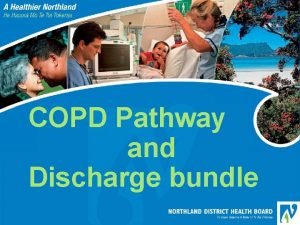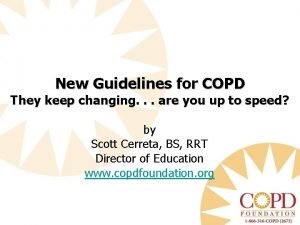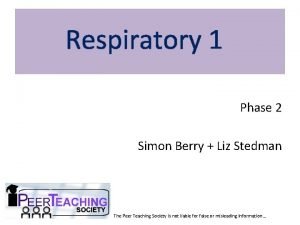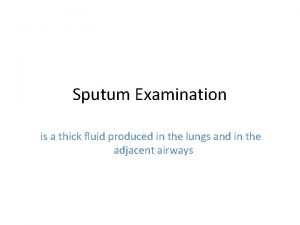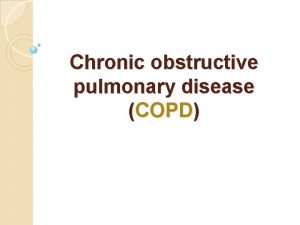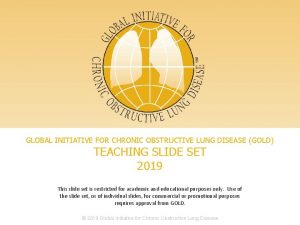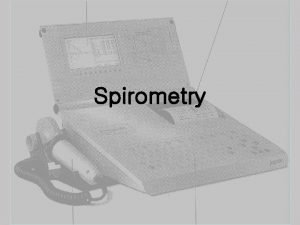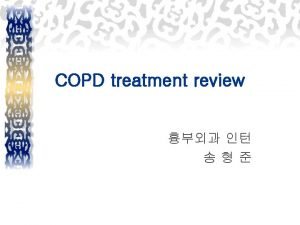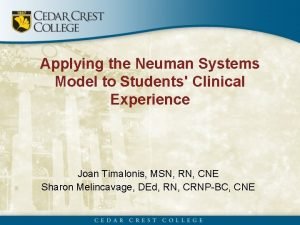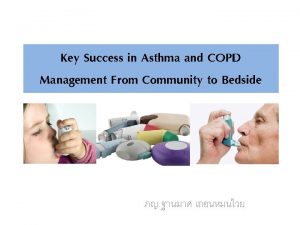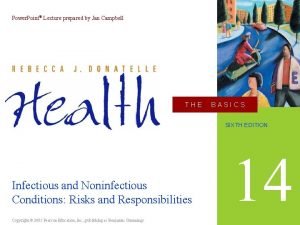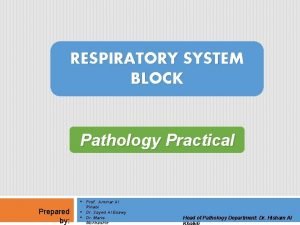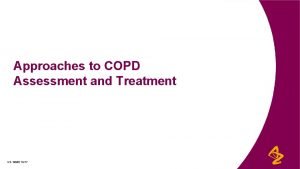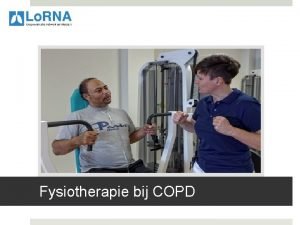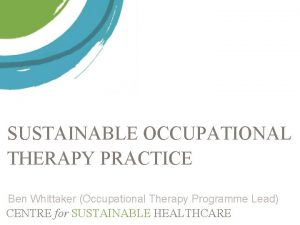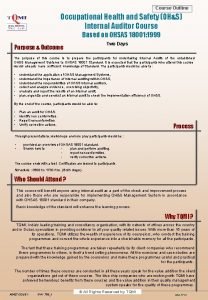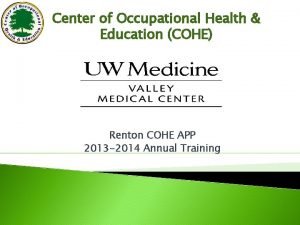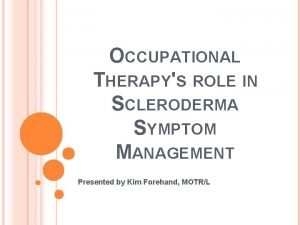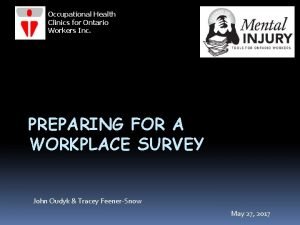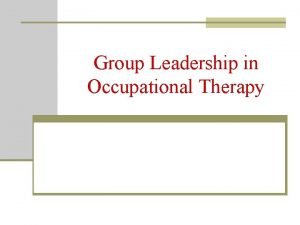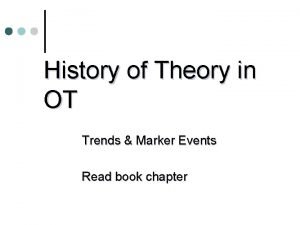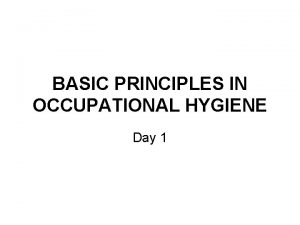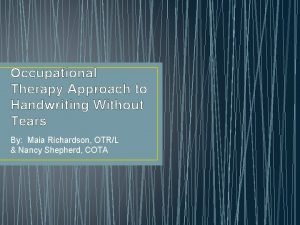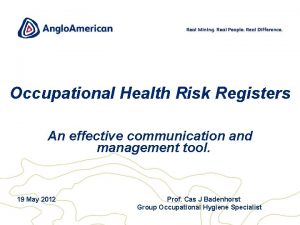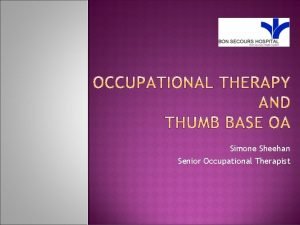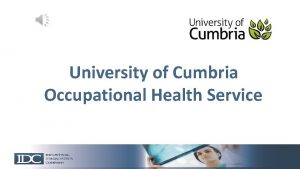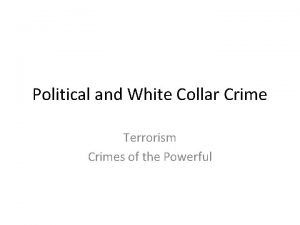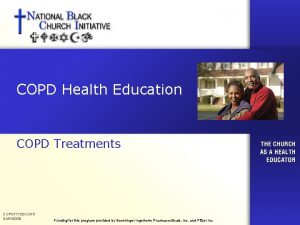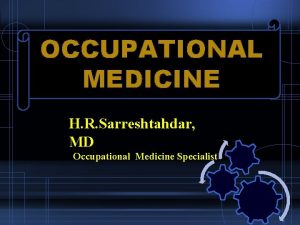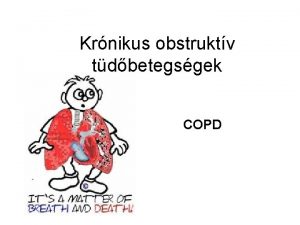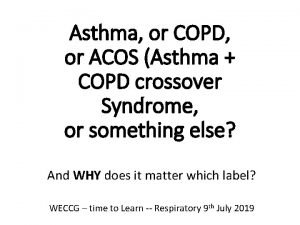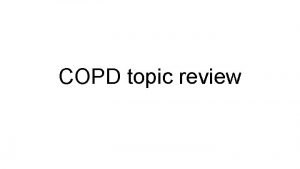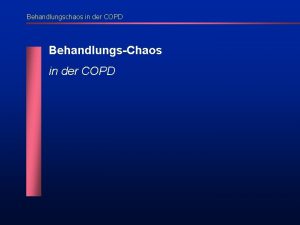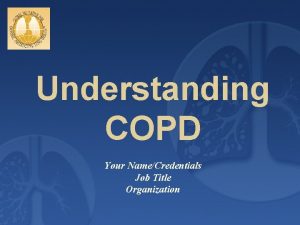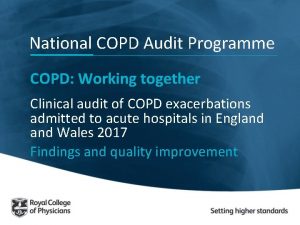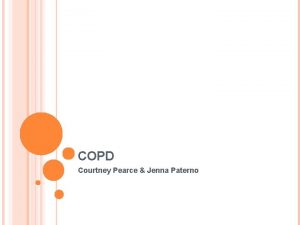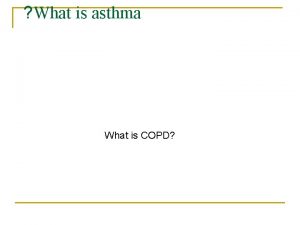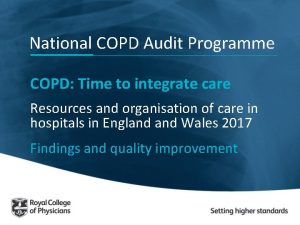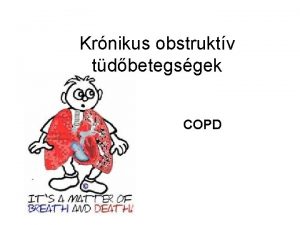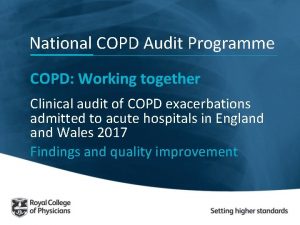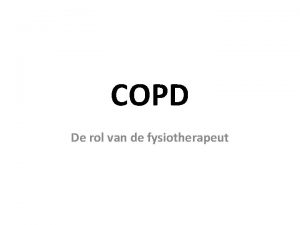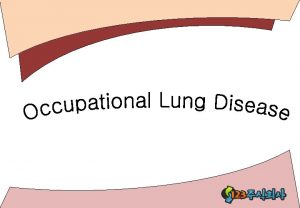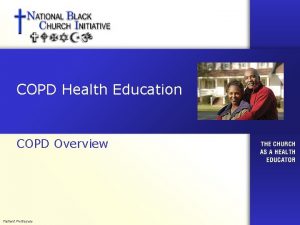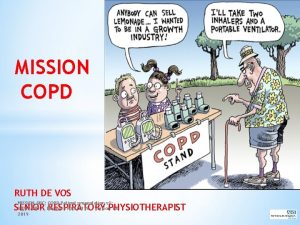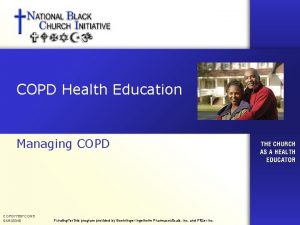Occupational COPD Kayvan Karamifar M D Occupational Medicine
























































- Slides: 56

Occupational COPD Kayvan Karamifar, M. D Occupational Medicine Specialist Department of Occupational Medicine Yazd University of Medical Sciences

Obstructive Pulmonary Disease • Chronic obstructive pulmonary disease (COPD) • Asthma • Bronchiectasis • Cystic fibrosis • Bronchiolitis obliterans • Alpha-1 -antitrypsin deficiency

Introduction • The commonest form of chronic lung disease in developed countries • Affecting 5 -10% of population • Associated with chronic bronchitis, emphysema, bronchiolitis and asthma any combination of these.

Definition of COPD • Chronic Obstructive Pulmonary Disease (COPD) is a preventable and treatable disease state characterised by airflow limitation that is not fully reversible. • The airflow limitation is usually progressive and associated with an abnormal inflammatory response of the lungs to noxious particles or gases, primarily caused by cigarette smoking.


COPD- Definitions • Emphysema – "an anatomical alteration of the lung characterized by an abnormal enlargement of the air-spaces distal to the non-respiratory bronchioles, accompanied by destructive changes of the alveolar walls. " • Chronic Bronchitis – " a clinical disorder characterized by excessive mucus secretion. . . chronic or recurrent productive cough. . . on most days for a minimum of three months in the year for not less than two successive years. "


Prevalence & Incidence




COPD: Risk Factors • Exposures – Smoking (generally ≥ 90%) – Passive smoking – Ambient air pollution – Occupational dust/chemicals – Childhood infections (severe respiratory, viral) – Socioeconomic status • Host factors – Alpha 1 -antitrypsin deficiency (<1%) – Hyperresponsive airways – Lung growth

Normal Chronic Bronchitis Emphysema



• Most reviewers now accept a causal occupational link and the conditions experienced by workers in several industries over recent decades are considered by many to be similar potency to cigarette smoking

Specific Occupational Causes • • • Coal dust Silica Asbestos Cadmium fumes Cotton dust • Grade 3 byssinosis • Grain dust • Wood dust • Agriculture • Metal fume – welding • Irritant gases • Combustion products – Firefighters

Diagnostic criteria for occupational COPD • Definite confirmation of diagnosis of COPD according to GOLD criteria or ATS criteria – Chronic bronchitis or emphysema or both • Confirmed exposure to one or more occupational etiologic agents – Sufficient exposure ( duration and intensity) – Minimum exposure duration required: • 20 years for coal dust • R/O of antitrypsin deficiency • Least role of cigarette smoking

Assess and Monitor Disease: Key Points • Diagnosis of COPD is based on a history of exposure to risk factors and the presence of airflow limitation that is not fully reversible, with or without the presence of symptoms.

Assess and Monitor Disease: Key Points • Patients who have chronic cough and sputum production with a history of exposure to risk factors should be tested for airflow limitation, even if they do not have dyspnea.


Diagnostic Criteria

Diagnosis of COPD EXPOSURE TO RISK FACTORS SYMPTOMS cough sputum dyspnea tobacco occupation indoor/outdoor pollution è SPIROMETRY












Emphysema- CXR



Emhpysema- HRCT Normal Emphysema

Normal Lung Centriacinar Emphysema Panacinar Emphysema

Emphysema- HRCT Centriacinar Emphysema Panacinar Emphysema






Chronic Bronchitis Cor Pulmonale - CXR



GOLD Guidelines for COPD Stage 0: At Risk Diagnosis Treatment • Chronic cough/sputum • PFTs within normal limits • No symptoms • Avoid risk factors (smoking cessation)

GOLD Guidelines for COPD Stage I: Mild Diagnosis Treatment • FEV 1 >80% predicted • FEV 1/FVC <70% • With/without symptoms • Avoid risk factors • Short-acting bronchodilator PRN

GOLD Guidelines for COPD Diagnosis Stage II: Moderate • 50% FEV 1 <80% predicted • FEV 1/FVC <70% • With/without symptoms Treatment • Avoid risk factors • Regular therapy with 1 bronchodilators • Inhaled corticosteroids if significant symptoms and lung function response • Rehabilitation

GOLD Guidelines for COPD Stage III: Severe Diagnosis Treatment • 30% FEV 1 < 50% predicted • FEV 1/FVC < 70% • With/without symptoms • Avoid risk factors • Regular therapy with 1 bronchodilators • Rehabilitation • Inhaled corticosteroids if significant symptoms and lung function response or if repeated exacerbations

GOLD Guidelines for COPD Stage IV: Very Severe Diagnosis • FEV 1 < 30% predicted • FEV 1/FVC < 70% • Respiratory failure • Right-side-of-the-heart failure Treatment • Avoid risk factors • Regular therapy with 1 bronchodilators • Inhaled corticosteroids if significant symptoms and lung function response or repeated exacerbations • Rehabilitation • Treatment of complications • Long-term O 2 therapy for hypoxic respiratory failure • Evaluate for surgical treatment


Impairment Rating

Medical Surveillance • Respiratory Questionnaire • Spirometry ( annually )
 Grand valley occupational medicine
Grand valley occupational medicine Confluence health occupational medicine
Confluence health occupational medicine Emphysema
Emphysema Copd obstruktionsgrad
Copd obstruktionsgrad Laatste fase copd
Laatste fase copd Copd national action plan
Copd national action plan Tiêu chuẩn anthonisen
Tiêu chuẩn anthonisen Copd full form
Copd full form Fever in copd
Fever in copd Left parasternal heave
Left parasternal heave What does barrel chested mean
What does barrel chested mean Asthma vs copd spirometry
Asthma vs copd spirometry Niv modes and settings
Niv modes and settings Centrilobular emphysema
Centrilobular emphysema Bitemporal wasting in copd
Bitemporal wasting in copd Gina asthma
Gina asthma Ipass the baton example
Ipass the baton example Copd stádiumai
Copd stádiumai Exacerbatie copd
Exacerbatie copd Copd exacerbation nursing management
Copd exacerbation nursing management Lets be copd
Lets be copd Cat score copd
Cat score copd Blue bloater vs pink puffer
Blue bloater vs pink puffer Color of phlegm chart
Color of phlegm chart Pulmonary disease definition
Pulmonary disease definition Copd step up
Copd step up Asthma vs copd spirometry
Asthma vs copd spirometry 4 levensdomeinen
4 levensdomeinen Terminale copd
Terminale copd Copd 저농도 산소
Copd 저농도 산소 Sbar copd
Sbar copd Blue and white inhaler
Blue and white inhaler Fever in copd
Fever in copd Copd full form in medical
Copd full form in medical Copd abcd assessment
Copd abcd assessment Copd netwerk
Copd netwerk Theory of occupational adaptation
Theory of occupational adaptation Occupational therapy and environmental sustainability
Occupational therapy and environmental sustainability Occupational health and safety course outline
Occupational health and safety course outline Alert program occupational therapy
Alert program occupational therapy Occupational health renton
Occupational health renton Scleroderma occupational therapy
Scleroderma occupational therapy Occupational health clinics for ontario workers purpose
Occupational health clinics for ontario workers purpose Leadership in occupational therapy
Leadership in occupational therapy Mary reilly occupational behavior model
Mary reilly occupational behavior model Basic principles of occupational hygiene
Basic principles of occupational hygiene Bioness bits cost
Bioness bits cost Handwriting without tears occupational therapy
Handwriting without tears occupational therapy Ummc occupational therapy
Ummc occupational therapy Occupational hygiene programme template
Occupational hygiene programme template Occupational health cardiff and vale
Occupational health cardiff and vale Simone sheehan
Simone sheehan Mat man handwriting without tears
Mat man handwriting without tears Be intentional in relationships
Be intentional in relationships Peo framework occupational therapy
Peo framework occupational therapy [email protected]
[email protected] Occupational crime in engineering ethics ppt
Occupational crime in engineering ethics ppt
